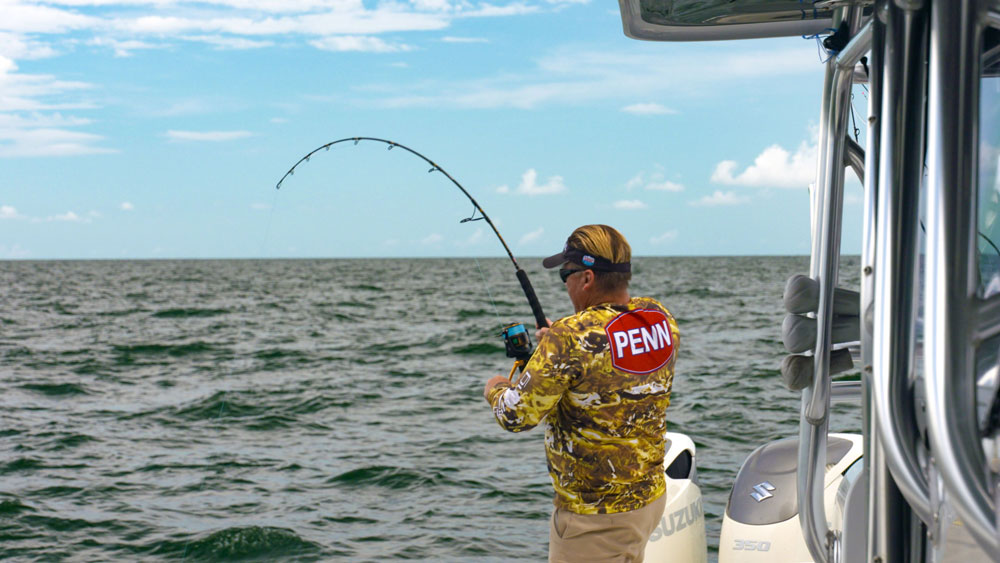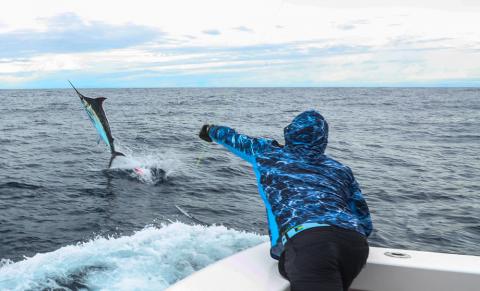with Mark Davis

Two things a fisherman can't control any day he goes fishing are the weather and the water. But when you have a TV show to do, you often have to try and make the show in spite of the weather and the water. When Mark Davis goes to film a show for “BigWater Adventures” that he hosts, often he has to find a way to overcome these two trip killers. Here’s what happened when chasing yellowfin tuna.
We were 90 miles offshore in Venice, Louisiana, looking for yellowfin tuna. Two days before, the water was clear and ideal for catching yellowfin, but when we went out two days later, the water looked like a chocolate malt. What many people don’t understand is that dirty water stays on top of clear water, and oftentimes 1-5 feet deep in muddy water, you will find gin-clear water. But that dirty water does affect the tuna regardless of how far down you find muddy water. Because of the loop currents, the wind and the muddy water coming down the Mississippi River and flowing out into the Gulf of Mexico, that muddy water can appear anywhere because of the large number of oil and gas rigs off the Louisiana coast. The yellowfin may be holding on any number of rigs. So, when a captain takes a party out to catch yellowfin, he can't know where those fish are holding.
We were fishing with the Mexican Gulf Fishing Company guides with Captain Kevin Beach. We were initially using live bait. The captain was looking for the right water temperature, the correct water color and the rig where he usually caught yellowfins. Generally, the boat hands will take a 5-gallon bucket of live bait, pour those live fish out over the back of the boat and put a hook in one of those live baits. The tuna will come up and feed on that large school of bait, and you should be able to hook one of them.
Then they’ll usually put two live baits on the outriggers and maybe drop one bait back and troll around that rig. First the boat will put out 50 feet of fluorocarbon leader with a circle hook tied on the end to 80-pound to 100-pound test Seaguar Threadlock braided line and then will use 30 to 80-class Penn roller rods and Penn torque 42 speed lever drag reels because of their high line capacity.
We were catching small yellowfins that weighed 40 to 50 pounds. But the way I caught the big yellowfin was when we saw a school of big yellowfin coming up right behind the boat and feeding on the surface, I threw a Halco Slidog, a big, topwater walking bait, much like a giant version of the Zara Spook. The bait is 8-inches long and weighs about 3 ounces. When I'm yellowfin fishing, I always have a heavy spinning rod rigged-up with a surface lure to be ready if I see tuna within casting distance, feeding on the surface.
The school of big tuna came up 50 to 70 yards off the bow, and I grabbed my spinning rod and launched that bait as far as I could to get the bait to the spot where I’d seen the tuna. As soon as the bait hit the water, I started retrieving the lure as fast as possible. One of those giant tuna came up and inhaled the lure. The bait I was using comes with single hooks, but I’d replaced those hooks with Gamakatsu 4X 5/0 treble hooks. I was fishing spinning tackle and 25 to 30 pounds of drag on the reel and got that yellowfin that weighed between 120 and 130 pounds up to the boat in about 20 minutes. His sickles (dorsal and anal fins) were about 2-feet long.



























